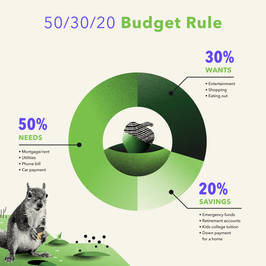Money Market Account vs. Savings Account: What's the Difference?

While investing is the best way to make your money grow over time, saving helps you plant the first seeds for financial success.
How much should you save? Ultimately, you want to set aside enough savings to cover your basic expenses for at least three to six months. The theory behind that rule of thumb is that if you unexpectedly find yourself out of work, your emergency fund should be able to keep you afloat financially while you figure out your next move.
Of course, not all financial emergencies are that dire, and working towards that ideal, big sum shouldn’t hold you back from investing. A good place to start is with a savings target of $1,000—enough to cover most run-of-the-mill emergencies, like a bit of car trouble or an emergency trip to the dentist. Then, you can continue to save while you also get started investing and working toward other financial goals.
But where should you stash that emergency cash? Unlike your investing dollars, which you shouldn’t need to touch for at least the next few years, your savings needs to be easily accessible. Under your mattress or in a literal piggy bank satisfies that criteria, but you have better options. Going with a savings account or money market account lets you dip into your funds at a moment’s notice while also keeping your money safe and earning interest. Neither type of account will earn you as much as you stand to make by investing, but you'll earn more than you would putting it under your mattress or leaving it in a checking account. Here's what you should know about savings and money market accounts.
What is a savings account?
It’s a bank account that keeps your money safe while it also earns a little interest. The safety feature stems from being insured by the Federal Deposit Insurance Corporation (FDIC) for up to $250,000, which means you cannot lose that money, even if the bank goes under. (That is, as long as the bank is FDIC-insured, so make sure that’s the case when you select your savings account.)
How much interest can you earn with a savings account?
Interest rates are determined by the bank or credit union, so it can vary greatly between accounts. The national average is a mere 0.21 percent, according to DepositAccounts—or 21 cents for every $100 you deposit. But among the top 1 percent of accounts, the average jumps up to 2.05 percent or more. Note, though, that some accounts offering top rates may come with fees or certain restrictions, like minimum balance requirements. For example, FitnessBank offers a maximum rate of 2.75 percent on its savings account, but requires a minimum average daily balance of $100. If you fall below that minimum requirement, you get charged $10 a month. Also, falling in line with FitnessBank’s quirky mission to combine financial and physical wellness goals (hence the bank’s name), you have to rack up an average 12,500 daily steps or more on the bank’s Step Tracker app to qualify for that top rate. (Seriously.)
How should you use a savings account?
Savings accounts offer a place to park money that you may need to access in the short term. You will earn some interest on it. But the primary goal is to be able to get quick access to that money when you need it.
What is a money market account?
Not to be confused with money market funds (which are a specific kind of mutual fund), money market accounts (MMAs) are very similar to savings accounts—with the security of being FDIC-insured for up to $250,000 and the ability to earn interest. (Money market funds are not FDIC-insured and can lose money just like any other investment.)
How much interest can you earn with a money market account?
Typically, MMAs offer slightly higher rates than savings accounts, with the national average being 0.26 percent, according to DepositAccounts, compared with the average 0.21 percent for savings accounts.
In exchange for the higher rates, they also tend to come with higher minimum balance requirements, in some cases up to $10,000 or $25,000.
How should you use a money market account?
You can also park cash in a money market account that you may need, as it's easy to access your money. In fact, money market accounts are more likely than savings accounts to also offer check-writing capabilities and ATM or debit cards. That can be an attractive feature, especially when you need to quickly tap your account.
But money market accounts also typically require you to keep a minimum balance in order to avoid fees and earn the higher interest rates. So they're usually better for mid-term goals that are a few years away. That way, you don't have to worry about going below the minimum balance, and can benefit from the typically higher rates, until you're ready to take that money out.
How are savings accounts and money market accounts similar?
Both savings accounts and money market accounts tend to offer significantly higher interest rates than you would earn on money you keep in a checking account. They are intended as accounts that allow you to save money for goals or emergencies, not to be used for everyday expenses.
It’s important to note that both money market accounts (or MMAs) and savings accounts are legally required to limit you to six withdrawals a month. If you go over that limit, you face penalty charges, and if you do it frequently enough, the bank can close your account. And fees and punishments aside, remember that these accounts are meant for saving, not spending, so you really shouldn’t need to dip into these funds very frequently at all. If you think the temptation to spend rather than save this money might be too much for you, the benefit of easy access to your money can quickly become a liability.
Which type of account is better?
Your call. The account types are so similar, either would make a fine choice as a place to store your savings. And there’s no need to limit yourself to just one or the other. But the details—including interest rates, minimum balance requirements, fees and accessibility—can vary so greatly between specific accounts that it’s important to shop around and make sure you’re getting the best possible deal for you. You can quickly compare accounts using sites like DepositAccounts, Bankrate and MagnifyMoney. Just be sure to dive into the fine print for each account you’re considering before you hand over your hard-earned cash.
In general, though, as long as you’re building up your savings and taking the time to find an account that will keep your money safe and growing, you’re already doing all the right things to help yourself achieve a bright financial future—regardless of which type of savings vehicle you ultimately choose.
This material has been presented for informational and educational purposes only. The views expressed in the articles above are generalized and may not be appropriate for all investors. The information contained in this article should not be construed as, and may not be used in connection with, an offer to sell, or a solicitation of an offer to buy or hold, an interest in any security or investment product. There is no guarantee that past performance will recur or result in a positive outcome. Carefully consider your financial situation, including investment objective, time horizon, risk tolerance, and fees prior to making any investment decisions. No level of diversification or asset allocation can ensure profits or guarantee against losses. Article contributors are not affiliated with Acorns Advisers, LLC. and do not provide investment advice to Acorns’ clients. Acorns is not engaged in rendering tax, legal or accounting advice. Please consult a qualified professional for this type of service.








